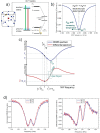Nanodiamond-Quantum Sensors Reveal Temperature Variation Associated to Hippocampal Neurons Firing
- PMID: 35876403
- PMCID: PMC9534962
- DOI: 10.1002/advs.202202014
Nanodiamond-Quantum Sensors Reveal Temperature Variation Associated to Hippocampal Neurons Firing
Erratum in
-
Nanodiamond-Quantum Sensors Reveal Temperature Variation Associated to Hippocampal Neurons Firing.Adv Sci (Weinh). 2023 Apr;10(11):e2301101. doi: 10.1002/advs.202301101. Adv Sci (Weinh). 2023. PMID: 37058686 Free PMC article. No abstract available.
Abstract
Temperature is one of the most relevant parameters for the regulation of intracellular processes. Measuring localized subcellular temperature gradients is fundamental for a deeper understanding of cell function, such as the genesis of action potentials, and cell metabolism. Notwithstanding several proposed techniques, at the moment detection of temperature fluctuations at the subcellular level still represents an ongoing challenge. Here, for the first time, temperature variations (1 °C) associated with potentiation and inhibition of neuronal firing is detected, by exploiting a nanoscale thermometer based on optically detected magnetic resonance in nanodiamonds. The results demonstrate that nitrogen-vacancy centers in nanodiamonds provide a tool for assessing various levels of neuronal spiking activity, since they are suitable for monitoring different temperature variations, respectively, associated with the spontaneous firing of hippocampal neurons, the disinhibition of GABAergic transmission and the silencing of the network. Conjugated with the high sensitivity of this technique (in perspective sensitive to < 0.1 °C variations), nanodiamonds pave the way to a systematic study of the generation of localized temperature gradients under physiological and pathological conditions. Furthermore, they prompt further studies explaining in detail the physiological mechanism originating this effect.
Keywords: ODMR; intracellular nanoscale sensing; nanodiamonds; nitrogen-vacancy (NV) centers.
© 2022 The Authors. Advanced Science published by Wiley-VCH GmbH.
Conflict of interest statement
The authors declare no conflict of interest.
Figures





References
-
- Robert C., Hue I., McGraw S., Gagné D., Sirard M. A., Quantification of Cyclin B1 and P34cdc2 in Bovine Cumulus‐Oocyte Complexes and Expression Mapping of Genes Involved in the Cell Cycle by Complementary DNA Macroarrays, Vol. 67, Sinauer Associates, Inc., Sunderland, MA, 2002, pp. 1456. - PubMed
-
- Howarth J. V., Ritchie J. M., Stagg D., Proc. R. Soc. London, Ser. B 1979, 205, 347. - PubMed
Publication types
MeSH terms
Substances
Grants and funding
LinkOut - more resources
Full Text Sources
